Are Wearables the Next Big Thing for AR?
Are Wearables the Next Big Thing for AR?
- Last Updated: December 2, 2024
Scottie Gardonio
- Last Updated: December 2, 2024



The Dramatic Intrigue of Fashion, Augmented Reality, and Functional Technology
(For the purposes of this article, the term augmented reality is used despite mixed reality also playing a part in many of the same spaces.)
With the recent launches of ARKit and ARCore, a reality that has long only been in the eyes of tech companies and startups is now being thrust into mainstream consumerism: augmented reality is coming at us with as many patents and as much speed-coding as can be mustered.
Not everyone is using augmented reality daily, though. Instead, they see it in the sidelines and hear about it briefly by way of a news article flying through a scrolling social media feed.
For consumers, the current trajectory is similar to Ghostbusters II scenes, circa 1989. Eager users are overtaken by the swift arrival of a previously unknown ghost train (think: Pokemon Go and Snapchat filters).

Image Credit: Ghostbusters, Columbia Pictures
The passing is quick, and soon users move on as there is nothing new to see.
Trudging down the abandoned, underground train tunnel, they then come upon a river of pink slime which envelops some onlookers and oozes its way through cracks and fissures to claim even those who were previously uninformed or uninterested (think: new, AR-enabled smartphones).
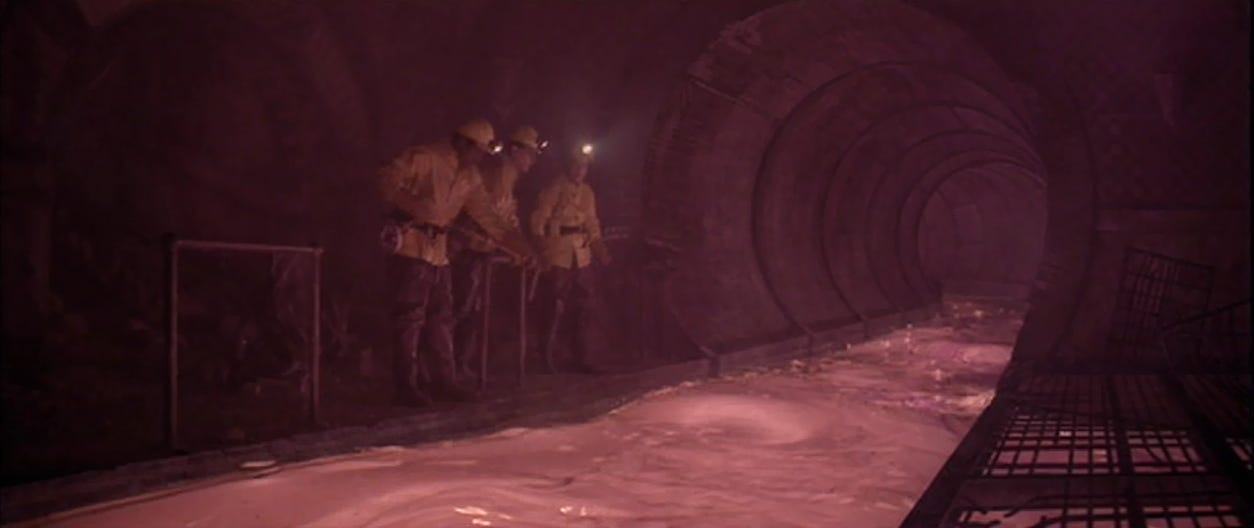
Who will be the saving grace? Will the pink slime of wearables be the evil force ultimately crippling the AR industry, or will someone play Your Love Keeps Lifting Me Higher and Higher to unleash the underlying positivity available?
In augmented reality, the use or non-use of wearables will be a deciding factor in how the future of the technology is developed and whether AR can become a functional, daily tool in everyday life.
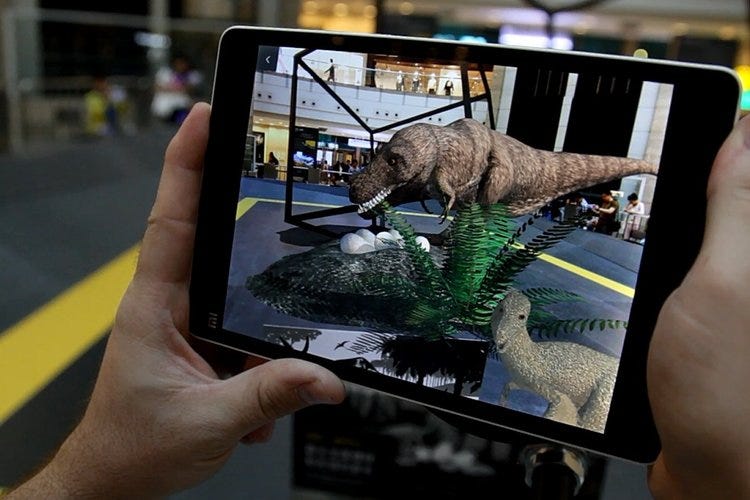
Why Bother with Wearables at All?
Let’s first say that there is an industry understanding that augmented reality cannot live on handheld devices alone.
Consumers have already spoken. While some functional tools, such as AR tape measures, are now available, the use still requires someone to hold a device and physically measure a space. The only real difference between this and an actual tape measure is that the user would no longer be required to carry a tape measure, and some spaces are easier to measure.
In the short term, until additional technology is developed, this is a great and necessary stepping stone familiarizing consumers with the new tech on devices they likely already own.
In the long term, however, the consumer will require more out of augmented reality than any handheld device can offer.
To better illustrate this point, let’s take a look at the interior design industry.
There’s no telling why you once thought orange shag carpeting, faux wood paneling, a mirror wall, and a pink Paisley couch went together. Everyone in your life is simply thankful you’ve decided to take the redecorating leap.
The current state of AR technology is getting closer to allowing users to see how new furniture and redecorating might look within their existing spaces.
(You can read more about this technology in Augmented and Virtual Reality Shopping — Retailers Beware.)
The challenges we see, however, are within the devices. While you might be excited to see how the new chaise lounge would look in your living room, viewing this potential through a handheld device allows you to see the mirror wall, paneling, and shag carpet out of your peripherals.
That’s right — the biggest issue we see with fully-functional future AR is the idea that we cannot fully optimize our field of view on a handheld device.
When wearables, such as devices looking similar to glasses, enter the world of possibility, we drastically increase the amount of immersion AR can play within our everydays.
Going back to the earlier example of a tape measure, imagine being able to simply run your eyes (with head movements) along a wall to gain a measurement instead of taking out your phone. If you were already wearing the glasses, as they are now an integral part of your daily tech attire, the steps necessary to complete a task decrease, which, in turn, validates a particular tool’s usefulness.

The Challenges of Wearables
While it may be easy to see why tech-enabled glasses would assist in the longterm use of augmented reality, serious pitfalls also exist.
1. They’re Ugly
OK, maybe they’re not (we haven’t seen all of the designs yet, and some may look really awesome), but we can be relatively sure that no one style will be attractive to every purchaser.
Take a look at the walls upon walls of frames seen in any optometry shop, and you’ll soon agree that a degree of individuality is required for anything we equate to being part of the fashion industry.
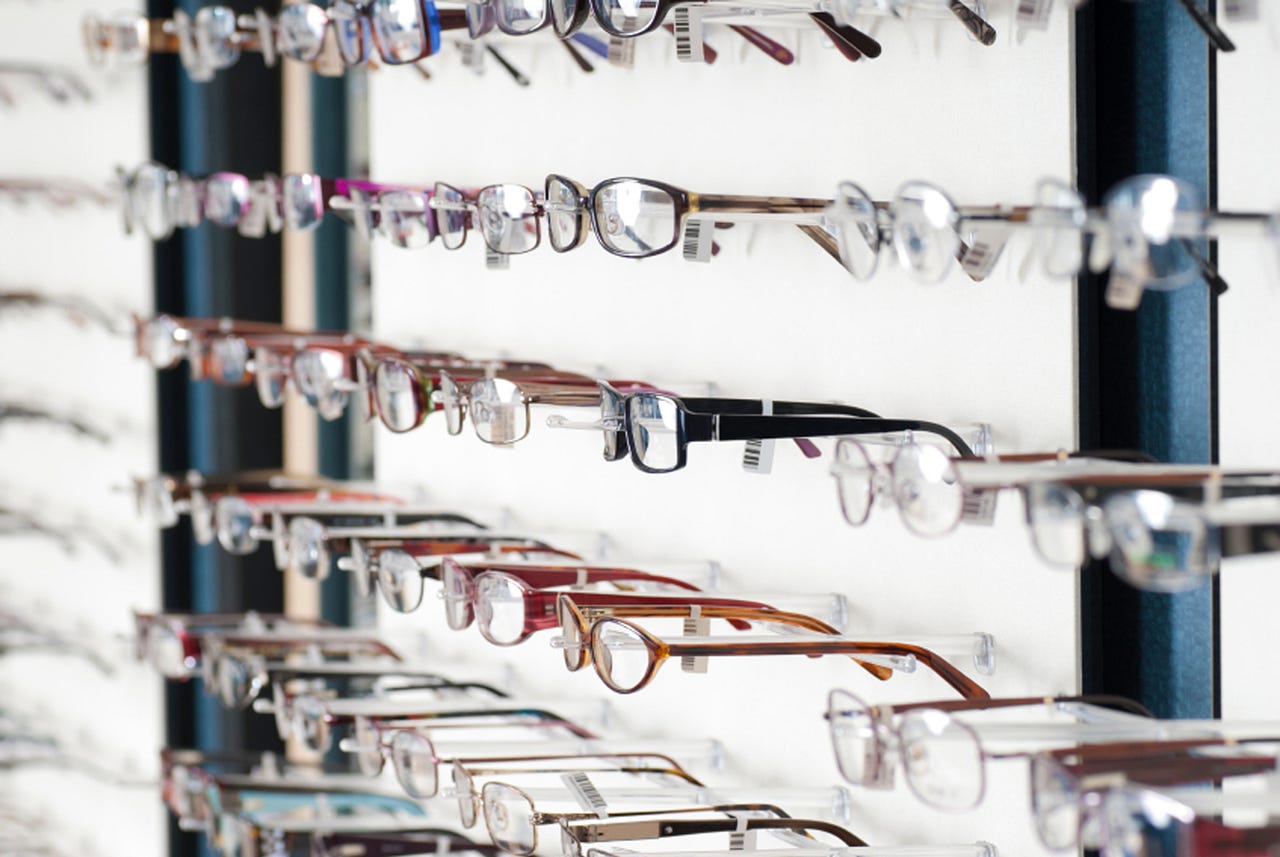
Different face shapes, ages, and comfort levels help dictate which pair of frames a person might choose. And, as many often associate their choice of eyewear being a glimpse into their personality (quirky, professional, reserved), we will see many abandon the idea of a one-size-fits-all accessory before it can be fully-immersed technology.
2. They’ll Only Work for Some
Do you already wear corrective lenses?
Are they contacts? Great — you can also wear AR wearables.
Are they glasses? Then too bad for you. You’re out of the AR game before it starts.
The same may be true for sunglass wearers. If a wearables company were to advertise an AR tool allowing truck drivers to see potential road hazards or construction before it affected traffic, it’s likely many trucking companies would be on board. However, if this comes at the cost of wearing sunglasses, the driver is now forced to choose between potentially helpful technology and the ability to see the road due to sun glare.
To be certain, some companies have created wearables which hang forward a bit further on a person’s head, so they can wear both corrective glasses and AR glasses together. But, who really wants to do this long term? Remember clip-on sunglasses? Yeah, those didn’t last, either.
3. They’re Uncomfortable
As of now, the amount of hardware required to operate AR functions is bulky. Quite bulky, and this makes for large, heavy and burdensome contraptions. Most people don’t want to wear a heavy headset all day, every day.
Some companies have lighter weight sets, though other companies who work with more intense functions, have even heavier contraptions. Almost all are substantially heavier than a standard set of frames.
And, while many of these companies are not advertising for mass-consumerism and don’t expect users to wear the sets from sun-up to sun-down, we can already imagine the stiff necks and AR My Pillow ads popping up as we try to rub out the kinks.

Image Credit: US Finance Post
As the technology evolves, we will likely see more advancements on an ergonomic level.
Some companies are already exploring options where the weighty portions of the hardware are placed into a separate, companion piece. With this, a person would be better able to keep an item (such as a pod or even a smartphone) in his/her pocket while wearing lightweight frames.
This is a monumental step toward creating a lightweight, comfortable wearable. However, consumers will likely be more apt to purchase an all-in-one device over a multi-piece (just think of all the different parts we’ll have to charge every day!).
4. Battery Life
We all know the challenges with quickly diminishing batteries in our mobile devices as they age, and wearables will see similar challenges.
Currently, the battery lives on such devices barely make it through a standard work shift. Should someone be using this technology for very specific, intermittent purposes, this may be a moot point.
However, as the goal is to make AR an all-day, every-day, life-altering, tech enhancement, consumers will need more. The wearable must endure through the day without requiring a charge, or consumers will abandon the products as the very use of them will be problematic.
The Future of Wearables
Right now, we know augmented reality is being developed as a more useful tool on handheld devices.
What is not as commonly known is the rate at which AR glasses patents are being filed. Every major technology company with an interest in augmented reality has filed for multiple patents, and each is racing to put forth their wearable first.

Apple’s wearable patent (Image Credit via NDTV)
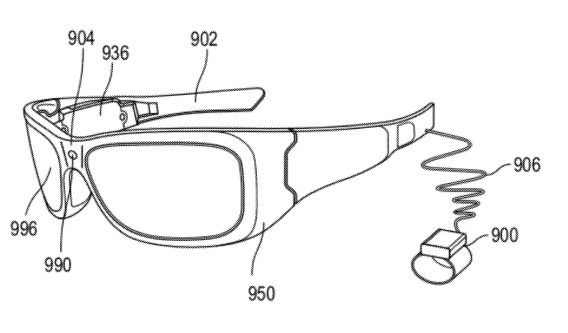
Microsoft's (Image Credit via Slate)

Snapchat's (Image Credit via Wearable
By just looking into those creating new wearables, it’s pretty clear that smartglasses will soon be mainstream. We’ll use them for fun by way of games, likely watch videos, shop, enjoy social media differently, and find an abundance of other useful operations.
We see wearables evolving in front of us, but what might come next?
Use Your Own Glasses
Perhaps you are one of the previously-mentioned, eliminated consumers who was out of the mix simply for wearing your own corrective lenses.
In the future, this challenge may be tackled differently.
Perhaps the wearables take off to such an extent that all frames are wearables. When you go to your eye doctor, you’re picking frames that come tech-enabled, or maybe you purchase from a slew of styles at your local tech store only to have the optometrist install the right lenses for you.
The lenses, themselves, have to be enabled in some way, though. This could be done by employing eye clinics to utilize certain types of glass or plastics. Or, perhaps a special film is overlaid on existing lenses in order to receive the signals needed for AR capabilities.
Eliminate the Idea of Glasses
In our current technology environment, the term “wearables” largely describes the idea of a headset or glasses. Other options come to mind, though.
1. Contact Lenses
As the tech evolves, is it too big of a leap to believe that one day the wearable will be contact lenses? Believe it or not, there is already dedicated research on this subject (with patents), though it is not as fast moving as the standard headset.
In this speculative SmartContact future, where there is no doubt also the invention of coffee that is always at the perfect temperature, the challenges we currently see within the wearables industry have been worked out.
Battery life issues have been resolved to a reasonable degree, the heaviness of the required hardware has been worked out enough to allow the viewing to be done within a small device (perhaps by way of the companion piece carried separately), and style issues are eliminated due to the contraption’s lack of visibility.
With something such as a contact lens, field of view issues we have with handheld devices and, to a degree, with headsets are eliminated. This would make for a truly augmented reality, and the immersion would be more seamless than in other devices.
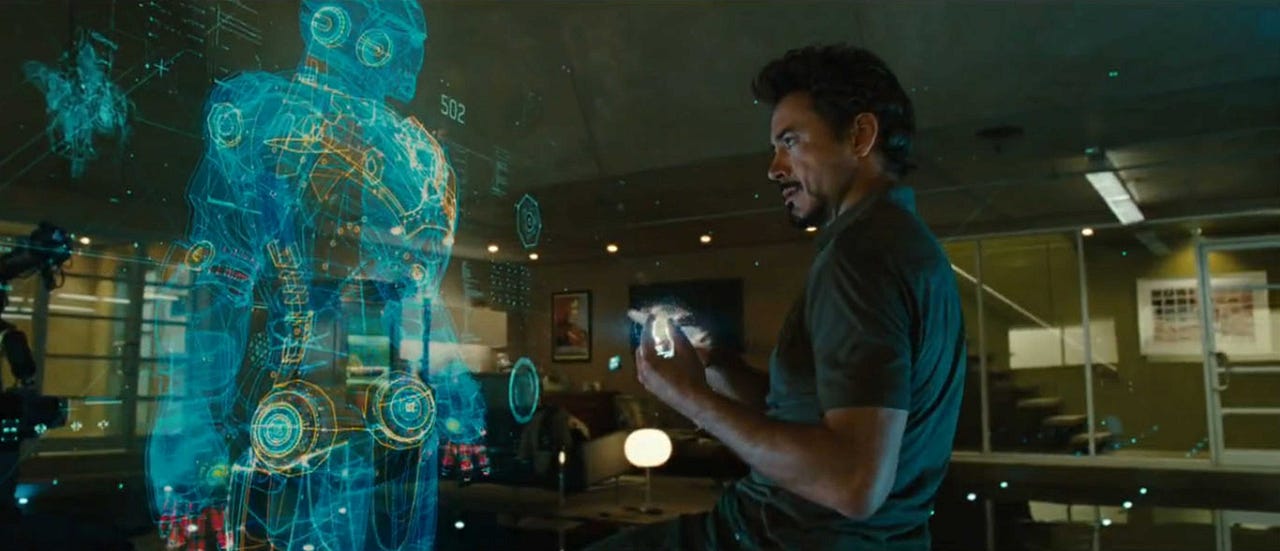
This article wouldn’t be complete without at least one Iron Man reference. Image Credit: Microsoft Hackster.io
2. Holograms
Another potential option is by way of a projected hologram. By clipping a device onto your clothing, or perhaps by way of a necklace, the images could be cast forward into your viewing.
This particular model poses it’s own challenges, of course. There would need to be some sort of interface allowing the user to interact with the projection in order for it to be a useable tool.
In addition to this, there is an issue with the viewing. More specifically, the issue is that everyone would be able to view one person’s hologram. When there isn’t a restriction by way of eyewear or handheld device, the projection then becomes available for all to see. And, if you imagine a New York City street full of hologram patrons all projecting different images simultaneously, I imagine your head hurts as much as mine.

Image courtesy
3. Chips
Another option, if we move so far into the future that Back to the Future Part II looks like a thing of the past, we may see the availability of AR-enabled implants.
In this tech scenario, we see chips being inserted directly into a human’s body, allowing for augmented reality enhancements. Now, without a daily wearable or recharging schedule, the projections happen within our own minds.
This cyborg-encroaching model may sound more far-fetched than it actually is. We are already seeing chips inserted beneath the skin of people for the purposes of easier lives in technology-related areas.
(If you’d like to read more about the current state of chipping outside of the AR world, take a gander at Chipping — Will We All Embed Sensors Under Our Skin?)
Implants are the most invasive, and arguably the most feared, AR leap. In order for the consumer to feel as though this is a viable option (assuming the technology was fully-developed, of course), the public would already need to to be fully-invested and have a commitment to the AR sphere.
We’re Going to Love Our Wearables
The road to mass-consumed wearables is going to be bumpy. We’ll see all of the mentioned challenges play out in realtime, and we’ll even discover more potholes not previously imagined.
However, as we traverse the new worlds and capabilities of AR, we’ll need to be given the tools from which we can embrace the technology. Right now, we see that in handheld devices, but soon it will be in the wearables offered.
Over time, the wearables will be more functional, more comfortable, better tailored for individual style, and widely accepted in both enterprise and consumer industries. They will be the happy portions of the dancing, pink Ghostbusters slime, and they will carry us toward future advancements.
From there, some of us will be witness to the evolution of AR immersion in such ways that we may not now be able to imagine. Eventually, in a world those of us who are alive today may never see, even more advanced technology will change the AR world in more dramatic ways.
Until then, we’re going to see a slow but inevitable influx of wearables, and we’re going to love it.
The Most Comprehensive IoT Newsletter for Enterprises
Showcasing the highest-quality content, resources, news, and insights from the world of the Internet of Things. Subscribe to remain informed and up-to-date.
New Podcast Episode

Moving Past the Pilot Phase in IoT and AI
Related Articles
Are We Running Out of Infrastructure Capacity? What IoT Leaders Need to Know
December 18, 2025

Clarity Wins: What the Blue Jays’ World Series Run Teaches Tech Leaders About Alignment and Execution
October 24, 2025

The 7 Worst Examples of IoT Hacking and Vulnerabilities in Recorded History
October 3, 2025
